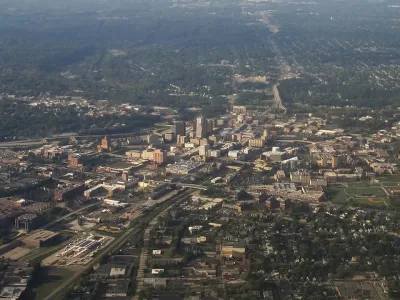The Lincoln Institute of Land Policy is launching the Legacy Cities Initiative to provide a network of support for cities of the country's industrial past.

A new legacy cities initiative launched this week with goals for supporting policy makers, civic leaders, and other stakeholders in cities with industrial pasts and fading middle class prosperity, sometimes called Rust Belt cities. Legacy cities are home to nearly 17 million people and a collective economy of $430 billion.
The Lincoln Institute of Land Policy is launching the initiative, with a new website and a request for expressions of interest in participation in the national network of legacy city community leaders.
According to an article by Emma Zehner, Allison Ehrich Bernstein, and Will Jason that announces the new initiative, the initiative will help community leaders in legacy cities "build on their city’s strengths and create a more equitable, sustainable, and prosperous future."
The Legacy Cities Initiative will offer webinars, peer exchanges, new research, and a community of practice of select leaders, who will meet regularly beginning in January 2021, according to the announcement.
FULL STORY: Lincoln Institute of Land Policy Launches Legacy Cities Initiative

Alabama: Trump Terminates Settlements for Black Communities Harmed By Raw Sewage
Trump deemed the landmark civil rights agreement “illegal DEI and environmental justice policy.”

Study: Maui’s Plan to Convert Vacation Rentals to Long-Term Housing Could Cause Nearly $1 Billion Economic Loss
The plan would reduce visitor accommodation by 25% resulting in 1,900 jobs lost.

Why Should We Subsidize Public Transportation?
Many public transit agencies face financial stress due to rising costs, declining fare revenue, and declining subsidies. Transit advocates must provide a strong business case for increasing public transit funding.

Paris Bike Boom Leads to Steep Drop in Air Pollution
The French city’s air quality has improved dramatically in the past 20 years, coinciding with a growth in cycling.

Why Housing Costs More to Build in California Than in Texas
Hard costs like labor and materials combined with ‘soft’ costs such as permitting make building in the San Francisco Bay Area almost three times as costly as in Texas cities.

San Diego County Sees a Rise in Urban Coyotes
San Diego County experiences a rise in urban coyotes, as sightings become prevalent throughout its urban neighbourhoods and surrounding areas.
Urban Design for Planners 1: Software Tools
This six-course series explores essential urban design concepts using open source software and equips planners with the tools they need to participate fully in the urban design process.
Planning for Universal Design
Learn the tools for implementing Universal Design in planning regulations.
Smith Gee Studio
Alamo Area Metropolitan Planning Organization
City of Santa Clarita
Institute for Housing and Urban Development Studies (IHS)
City of Grandview
Harvard GSD Executive Education
Toledo-Lucas County Plan Commissions
Salt Lake City
NYU Wagner Graduate School of Public Service





























